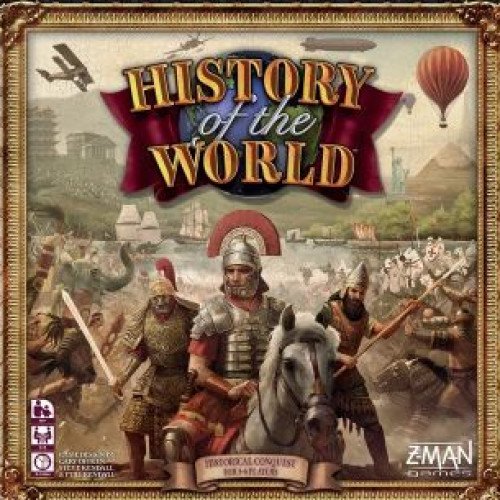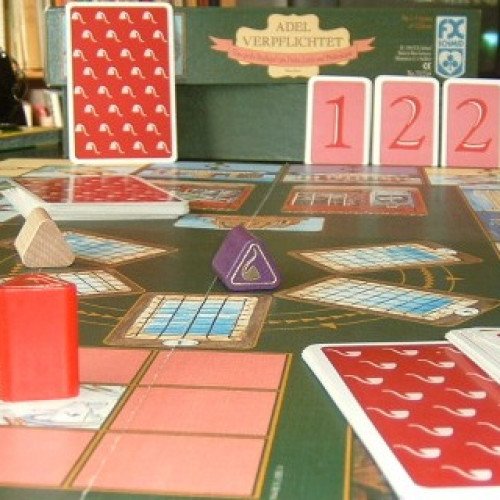"HISTORY OF THE WORLD" vs "HOITY TOITY"

HISTORY OF THE WORLD
History of the World (often abbreviated HotW) is a board game designed by Ragnar Brothers and originally published in 1991. It is played by up to six players in seven epochs (6 epochs in the 2009 edition, and 5 epochs in the 2018 edition), each player playing a different empire in each epoch. The first edition of History of the World by Ragnar Brothers was released in 1991 (with a tea-towel board). This first edition sold out in a few weeks, according to Game Designer, Steve Kendall. Following English, Dutch and German versions by various publishers, it was published by Avalon Hill in 1993. After Avalon Hill was purchased by Hasbro in the early 2000s, History of the World was re released as a big box game. Ragnar Brothers released a revised version of the game, A Brief History of the World, in 2009. The Game was then handed to Z-Man Games who created the most recent edition in 2018. The 2018 version contains updated art and is considered the most visually appealing of all the versions. The game is played in seven rounds known as epochs (6 epochs in the 2009 edition, and 5 epochs in the 2018 edition), which correspond to different historical periods. At the beginning of each epoch, each player receives an empire card and assumes the role of that empire for the round. Each empire has advantages and disadvantages based on the order in which it appears in an epoch, starting location on the world map, its number of armies, navigation abilities (access to certain lands by sea), and whether or not it possesses a capital. Empires not having capitals are known as Marauders and they gain points for sacking other players structures. During each empire's turn, its allocated units are placed on the board beginning from its capital (or starting space) and proceeding through contiguous areas and controlled seas or oceans. Occupation of empty territory is automatic, while dice-based combat rules are applied if a unit is placed in an area already occupied by another player's forces. At the end of each player's turn, they are given a score based on how much control they have of regions of the board (known as "Areas") and how many capital, cities, and monuments they possess. The remains of players' empires never move again, but remain on the board for the rest of the game until they are conquered or destroyed by other empires. Players are also given "Greater Events" and "Lesser Events" cards at the beginning of the game, which can be used throughout the game to gain certain advantages. The following is list of all the empires in the game grouped by epoch and organized by their order of play in each epoch. Each empire is listed with its name, the number of armies it gets, its capital or starting location in parentheses, and the seas it can navigate in parentheses. Each epoch there is a minor empire and a kingdom that can be played as event cards, and these are listed at the bottom of the epoch. For the Epochs in 2018 continue reading to a different section.
Statistics for this Xoptio

HOITY TOITY
Hoity Toity (German: Adel Verpflichtet, Noblesse oblige) is a board game created by Klaus Teuber in 1990. German game designer Klaus Teuber created Adel Verpflichtet in 1990, and it was published in Germany by F.X. Schmid. It was also distributed in the United Kingdom under the name Fair Means or Foul, and in the United States both under its German name and as By Hook or Crook. In 2008, Überplay re-released it in the United States using the name Hoity Toity. The game won several awards. The players in the game represent the members of the pretentious Antique Club who collectively wager which one of them can acquire, by purchase or theft, the most expensive collection of objets d'art in one day. Each member has at their disposal a detective and two thieves. During each turn, each player must choose to either go to the auction house or go to the castle. If a player goes to the auction house, the player can either bid on an item in a secret bid process, or send a thief. If only one thief is sent, the thief steals all the cash that was used for bidding. If more than one player sends a thief, then neither is able to steal the cash and the auction proceeds. The auctioned item then goes to the highest bidder. If a player goes to the castle, the player has three options: exhibit the items collected thus far, which will enable the player to move around the board further towards the end; send a thief to steal something; or send the detective to arrest any thief who is present. The player who completes a circuit of the board and arrives back in the club first is the winner.